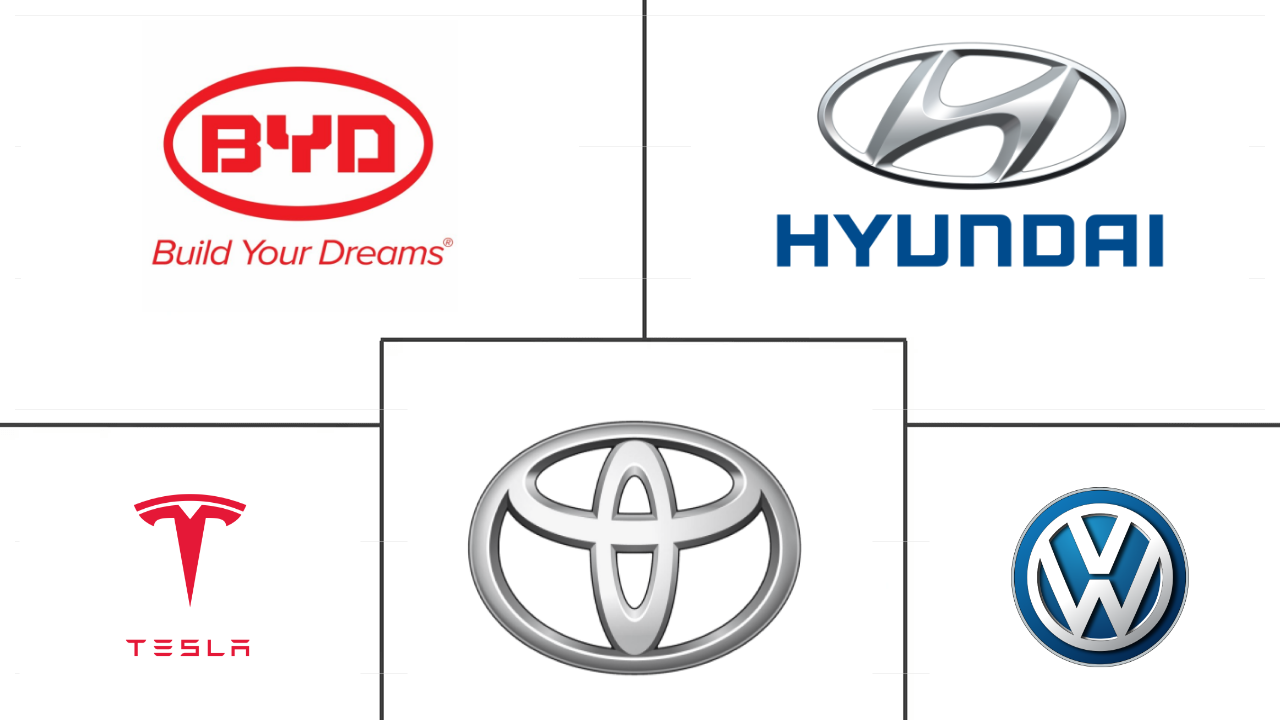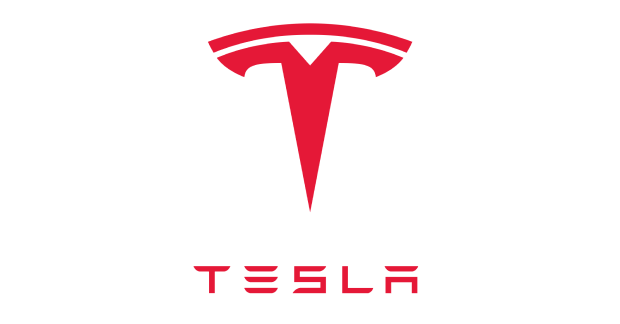Market Size of electric cars Industry
| Icons | Lable | Value |
|---|---|---|
|
|
Study Period | 2017 - 2030 |
|
|
Market Size (2024) | USD 0.96 Trillion |
|
|
Market Size (2030) | USD 2.48 Trillion |
|
|
CAGR (2024 - 2030) | 17.09 % |
|
|
Largest Share by Region | Asia-Pacific |
|
|
Market Concentration | Medium |
Major Players |
||

|
||
|
*Disclaimer: Major Players sorted in no particular order |
Electric Cars Market Analysis
The Electric Cars Market size is estimated at 0.96 trillion USD in 2024, and is expected to reach 2.48 trillion USD by 2030, growing at a CAGR of 17.09% during the forecast period (2024-2030).
0.96 Trillion
Market Size in 2024 (USD)
2.48 Trillion
Market Size in 2030 (USD)
40.36 %
CAGR (2017-2023)
17.09 %
CAGR (2024-2030)
Largest Segment by Fuel Category
58.77 %
value share, BEV, 2023
BEVs dominate globally due to technological advancements, extensive government support, and growing consumer preference for zero-emission vehicles.
Fastest-growing Segment by Fuel Category
34.58 %
Projected CAGR, FCEV, 2024-2030
FCEVs are the fastest-growing segment globally due to rapid advancements in hydrogen technology and increased investment in hydrogen infrastructure.
Largest Country Market
53.61 %
value share, China, 2023
China leads the global electric car market due to its large population, significant manufacturing capacity, and strong government policies promoting electric vehicle adoption.
Fastest-growing Segment by Country
46.74 %
Projected CAGR, Mexico, 2024-2030
Mexico is the fastest-growing segment due to increasing government support for electric vehicles, expanding charging infrastructure, and rising consumer awareness about the benefits of EVs.
Leading Market Player
19.90 %
market share, Tesla Inc., 2023

Tesla is the leading market player with a market share of around 14% in the global electric car market. Tesla sells its products in North America, Europe and Middle east countries.
Increasing demand for vehicles mitigating the negative environmental impacts associated with fossil fuels is boosting the growth of the market
- The automotive sector was significantly impacted by the global chip shortages and supply chain disruptions stemming from the COVID-19 pandemic. Despite this, Tesla faced criticism for its perceived contributions to climate change, both in its manufacturing practices and the vehicles it produces. Notably, EU consumers are increasingly opting for vehicles that mitigate the negative environmental impacts associated with fossil fuels.
- The global automotive market witnessed significant repercussions from the COVID-19 pandemic in the past year. As travel restrictions were imposed worldwide in response to the pandemic, the industry faced several setbacks. In 2020, global car sales reached 63.8 million units. While a modest recovery was anticipated in 2021, and around 66 million cars were expected to be sold, major players like Toyota and the Volkswagen Group saw their deliveries decline by over a million units.
- In 2021, approximately 56.4 million passenger cars were In 2021, global passenger car sales reached approximately 56.4 million units, marking a nearly 5% increase from the previous year. China emerged as the largest regional market, accounting for just under 21.5 million units. The automotive landscape is poised for significant transformation in the coming decade. By 2030, it is projected that electric vehicles will make up around 26% of global new car sales. Around 58 million self-driving cars joined the global fleet by 2022. Such technological advancements are reshaping the automotive supply chain, particularly in the realm of automotive electronics. With the rise of automation and electrification, the future of the automotive market looks promising.
- Consumer spending on electric car purchases increased to USD 120 billion in 2020. Governments worldwide spent nearly USD 14 billion to encourage the sales of electric vehicles, which increased by 25% in 2019, primarily due to increased incentives in Europe. The output of automotive batteries increased by 33% from 2019 to 160 GWh, and their cost decreased by 13% to an average of USD 137/kWh per battery pack globally in 2020. Worldwide government National EV Policy stipulates that when buying or leasing an electric vehicle (EV), whether new or used, drivers are exempt from both purchase tax and VAT. EV owners are also excluded from paying an annual road traffic insurance charge.
- Many government policies boast the world's largest per capita fleet of plug-in electric cars and offer several enticing incentives for buying electric vehicles. For instance, there are currently more than 16,000 charging stations in Norway, up from just 3,000 in 2011. On all important routes, including the highest fast-charging station in the entire world, the Norwegian government has erected fast-charging stations every 50 km. EV charging stations appear to have a promising future in Norway.
- There are several highly attractive incentives for electric vehicles globally. Overall, many countries signed Paris climate policy targets, which call for a 40% decrease in greenhouse gas emissions by 2030, which are supported by the automobile policy. National vehicle targets, including the sale of entirely zero-emission cars by 2030, were already established by the National Transport Plan in 2017. Norway has also committed to reducing greenhouse gas emissions by at least 40% by 2030. These factors are all expected to boost the Norwegian electric car market over the forecast period.
Electric Cars Industry Segmentation
Passenger Cars are covered as segments by Vehicle Configuration. BEV, FCEV, HEV, PHEV are covered as segments by Fuel Category. Africa, Asia-Pacific, Europe, Middle East, North America, South America are covered as segments by Region.
- The automotive sector was significantly impacted by the global chip shortages and supply chain disruptions stemming from the COVID-19 pandemic. Despite this, Tesla faced criticism for its perceived contributions to climate change, both in its manufacturing practices and the vehicles it produces. Notably, EU consumers are increasingly opting for vehicles that mitigate the negative environmental impacts associated with fossil fuels.
- The global automotive market witnessed significant repercussions from the COVID-19 pandemic in the past year. As travel restrictions were imposed worldwide in response to the pandemic, the industry faced several setbacks. In 2020, global car sales reached 63.8 million units. While a modest recovery was anticipated in 2021, and around 66 million cars were expected to be sold, major players like Toyota and the Volkswagen Group saw their deliveries decline by over a million units.
- In 2021, approximately 56.4 million passenger cars were In 2021, global passenger car sales reached approximately 56.4 million units, marking a nearly 5% increase from the previous year. China emerged as the largest regional market, accounting for just under 21.5 million units. The automotive landscape is poised for significant transformation in the coming decade. By 2030, it is projected that electric vehicles will make up around 26% of global new car sales. Around 58 million self-driving cars joined the global fleet by 2022. Such technological advancements are reshaping the automotive supply chain, particularly in the realm of automotive electronics. With the rise of automation and electrification, the future of the automotive market looks promising.
| Vehicle Configuration | |||
|
| Fuel Category | |
| BEV | |
| FCEV | |
| HEV | |
| PHEV |
| Region | ||||
| ||||
| ||||
| ||||
| ||||
| ||||
|
Electric Cars Market Size Summary
The electric cars market is experiencing a significant transformation, driven by advancements in battery technology, vehicle electrification, and supportive government policies aimed at reducing greenhouse gas emissions. The automotive industry, which faced challenges due to global chip shortages and supply chain disruptions during the COVID-19 pandemic, is now witnessing a robust recovery with a focus on electric vehicles (EVs). The market is expected to expand considerably over the coming years, with electric vehicles becoming an integral part of the automotive landscape. This shift is fueled by increasing consumer demand for environmentally friendly vehicles and the implementation of national policies promoting zero-emission cars. Regions like Asia-Pacific and Europe are leading the charge in EV production, supported by strategic initiatives from major manufacturers such as Kia Motors, which is actively expanding its electric vehicle lineup.
The market is moderately consolidated, with key players like BYD Auto Co. Ltd., Hyundai Motor Company, Tesla Inc., Toyota Motor Corporation, and Volkswagen AG holding significant shares. These companies are not only focusing on expanding their electric vehicle offerings but also on achieving ambitious sustainability goals, such as carbon neutrality by 2050. The rise in consumer spending on electric cars, coupled with government incentives and the establishment of extensive charging infrastructure, is expected to drive the market's growth. As a result, electric vehicles are projected to account for a substantial portion of global new car sales by the end of the decade, marking a pivotal shift in the automotive industry towards sustainability and innovation.
Electric Cars Market Size - Table of Contents
-
1. MARKET SEGMENTATION (includes market size in Value in USD and Volume, Forecasts up to 2030 and analysis of growth prospects)
-
1.1 Vehicle Configuration
-
1.1.1 Passenger Cars
-
1.1.1.1 Multi-purpose Vehicle
-
-
-
1.2 Fuel Category
-
1.2.1 BEV
-
1.2.2 FCEV
-
1.2.3 HEV
-
1.2.4 PHEV
-
-
1.3 Region
-
1.3.1 Africa
-
1.3.1.1 South Africa
-
-
1.3.2 Asia-Pacific
-
1.3.2.1 India
-
-
1.3.3 Europe
-
1.3.3.1 Czech Republic
-
1.3.3.2 UK
-
-
1.3.4 Middle East
-
1.3.4.1 UAE
-
-
1.3.5 North America
-
1.3.5.1 Mexico
-
-
1.3.6 South America
-
1.3.6.1 Brazil
-
-
-
Electric Cars Market Size FAQs
How big is the Global Electric Cars Market?
The Global Electric Cars Market size is expected to reach USD 963.66 billion in 2024 and grow at a CAGR of 17.09% to reach USD 2483.88 billion by 2030.
What is the current Global Electric Cars Market size?
In 2024, the Global Electric Cars Market size is expected to reach USD 963.66 billion.

